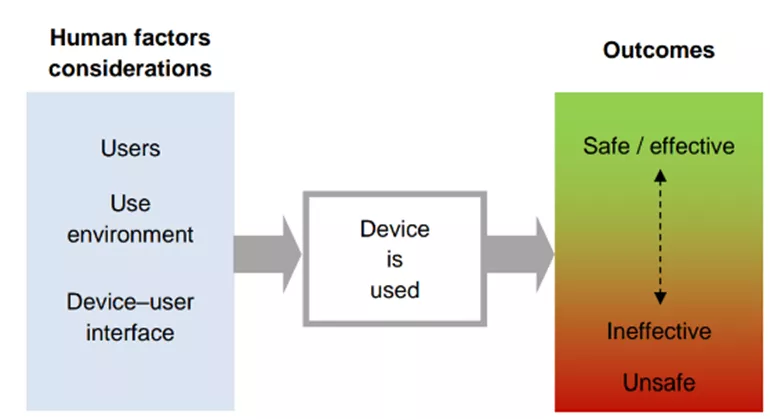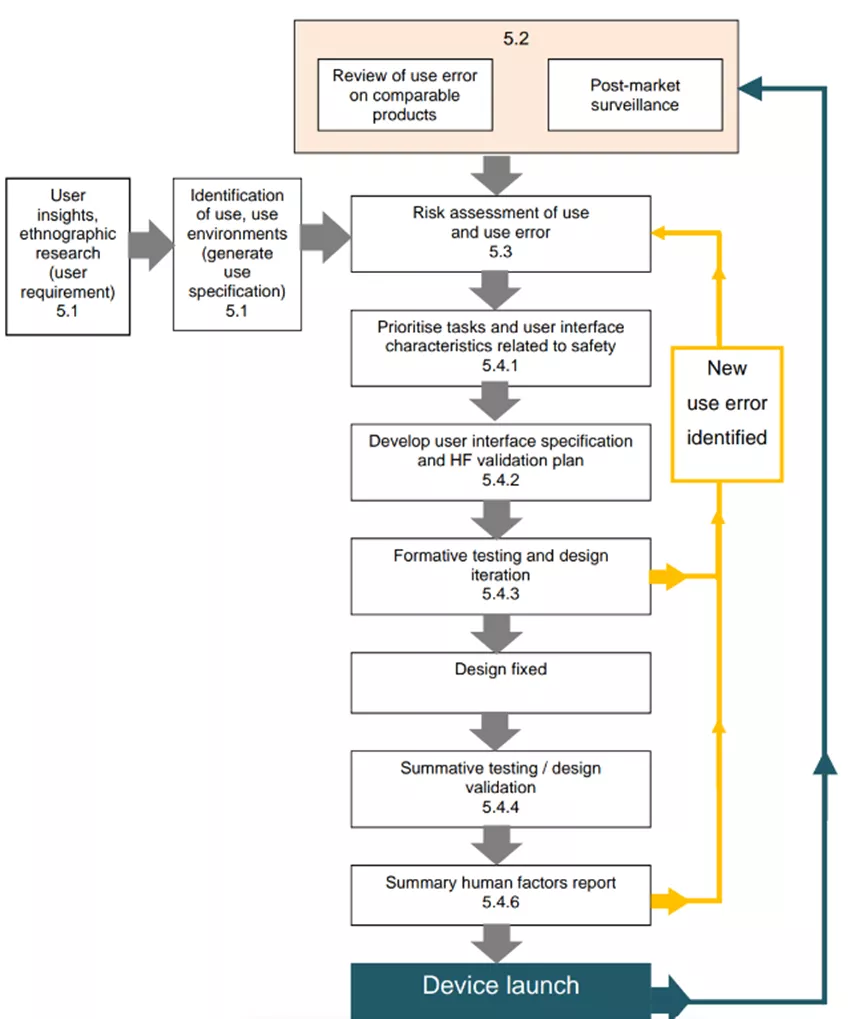Importance of Human Factors Engineering in Medical Device Domain
Ergonomics (or human factors) is the scientific discipline concerned with the understanding of interactions among humans and other elements of a system, and the profession that applies theory, principles, data, and methods to design to optimize human well-being and overall system performance.

Human Factors Engineering is the application of knowledge about human behaviour, abilities, limitations, and other characteristics of medical device users to the design of medical devices including mechanical and software driven user interfaces, systems, tasks, user documentation, and user training to enhance and demonstrate safe and effective use.
The terms Human factors engineering (HFE) and usability engineering (UE) can be considered to be synonymous.
Human Factors Engineering = “Integrating human factors requirements into design”
Introduction
The usability engineering process aims to deliver products that are user-friendly and safe when used according to their intended purpose, by intended users, and in the intended use environment. Ideally, users should not have to struggle with complex instructions for use or adapt to the device's requirements, nor should they use it incorrectly or in a potentially dangerous manner. Therefore, a well-designed product should be easy to use and have a user interface that aligns with user experiences and expectations.
This article provides a concise overview of the Usability Engineering/ Human Factors Engineering process, emphasizes the crucial role of Human Factors Engineering in the medical device domain and its profound implications for patient safety, and delves into the regulatory framework associated with these aspects.
History
The term "Human Factors" came into prominence during World War II, marking a significant transformation in the approach to design thinking. It took the experiences of two world wars for designers to recognize the critical role of the Human Factor. Before World War I, the prevailing objective was to adapt humans to machines. However, the advent of aircraft in warfare introduced the concept of aviation psychology, which aimed to tailor machines to fit human capabilities.
Many practitioners who served in World War II witnessed numerous system designs that were challenging to operate and posed safety risks. This realization led to a shift in focus, emphasizing user-friendly designs rather than excessive reliance on training, with the expectation that users would become more capable over time. Although initially applied in the aviation and aerospace industry, human factors principles have now permeated various sectors, including healthcare, software, oil and gas, chemicals, and automobile manufacturing.
Human factors: why they matter for patient safety
The increased utilization of medical devices for diagnostic, monitoring, and therapeutic purposes has resulted in a rise in usage errors that can harm patients. Such errors often stem from inadequate device design, particularly in devices with complex user interfaces. Examples of medical devices prone to potential design issues include ventilators, infusion pumps, automatic electronic defibrillators (AEDs), and auto-injectors. These design issues can lead to problems such as medication overdoses, incorrect therapy, and challenges in delivering medication.
As medical devices continue to advance in their capabilities and are used in increasingly busy environments with new distractions and specialized training requirements, the likelihood of usage errors also escalates. Moreover, with the evolving healthcare landscape, including the transfer of patient care to home settings, there is a need to ensure that even less skilled or unskilled users, such as patients and caregivers, can safely operate complex medical devices.
Regulatory framework
The absence of human factors considerations in the design of medical devices can result in counter-intuitive interfaces that are difficult to learn, comprehend, interpret, and use. Consequently, this can lead to errors and have adverse effects on patient safety. Over the past two decades, medical errors of this nature have caused adverse events, including severe injuries and patient fatalities. There has been an alarming upward trend in post-market events associated with user interface (UI) design issues.
In response to the increasing occurrence of adverse events caused by UI-related factors, the US Food and Drug Administration (FDA) now mandates human factors and usability engineering reviews as a routine part of their pre-market approval process. This review process is conducted by the Office of Device Evaluation within the Centre for Devices and Radiological Health (CDRH). In December 2022, FDA. released a draft guidance document titled "Content of Human Factors Information in Medical Device Marketing Submissions." This guidance serves as a complement to the previous one and specifically focuses on the type of human factors data that manufacturers should include in their marketing submissions.
In a similar vein, the International Electrotechnical Commission (IEC) has incorporated IEC 62366-1, which replaces IEC 62366 and pertains to the application of usability engineering in medical devices. Both the FDA guidance and IEC 62366-1 outline a process that encompasses activities throughout device development, including validation testing of the final user interface (UI) design in simulated use environments.
Overview of the HFE/UE process
According to the FDA guidance [4], human factors engineering (HFE), and usability engineering (UE) primarily focus on understanding how people interact with technology and studying the impact of UI design on those interactions.
The development of medical devices with HFE/UE considerations involves three main components:
- device users,
- device use environments, and
- device user interfaces.
The interactions among these components are illustrated in Figure 1, where human factors influence the outcomes of using medical devices.

Figure 1 Human factors affect outcomes of using medical devices (MHRA guidance)
Use-related hazards associated with user interactions with medical devices should be addressed in the risk management process. These hazards arise from aspects of the user interface design that may cause users to inadequately perceive, read, interpret, understand, or respond to information from the device. Some use-related hazards are more critical than others, depending on the potential harm to the user or patient.
HFE/UE activities need to be carried out at every stage of the design and development process for a medical device. This includes initial task and risk analysis, designing and evaluating the user interface (UI), and conducting final summative validation testing using simulated scenarios. This process needs to align with the overall risk management approach for the device. To determine the acceptability of use-related risks, decisions should be based on the outcomes of simulated use testing involving representative users.
This assessment should focus on identifying any persistent patterns of failures or difficulties in tasks that have significant risk implications. The provided flowchart (Figure 2) exemplifies the iterative nature of the usability engineering process, as outlined in the MHRA guidance.

Figure 2 Example of usability engineering process (MHRA guidance)
Conclusion
Human factors engineering and usability engineering are becoming integral to the development of medical devices, ensuring their safety and ease of use. Regulators now follow a systematic approach to review manufacturers' compliance with usability engineering standards. Professionals from diverse disciplines are actively leveraging their unique skills and abilities to study how people interact with devices. As technology continues to advance, the field of human factors will continuously expand, contributing to advancements in patient safety within the clinical environment.
REFERENCES
- IEC 62366-1 Medical devices — Part 1: Application of usability engineering to medical devices
- IEC 62366-2 Medical devices – Part 2: Guidance on the application of usability engineering to medical devices
- FDA Guidance: Medical Device Use-Safety: Incorporating Human Factors Engineering into Risk Management.
- FDA Guidance: Applying Human Factors and Usability Engineering to Medical Devices
- FDA Guidance: Applying Human Factors Engineering to Combination Products
- AAMI/ANSI HE75: Human Factors Engineering – Design of Medical Devices
- MHRA Guidance on applying human factors and usability engineering to medical devices including drug-device combination products in Great Britain
- BSI Whitepaper: The growing role of human factors and usability engineering for medical devices

This blog is written by Deepareddy G, Sr. Systems Engineer (Human Factors) at Decos. She is expert in Systems, Human Factors, RA&QA and comes with wealth of experience in medical device regulations, R&D, Usability/ Human Factors.
Decos is a cutting-edge technology services partner ready to meet your software needs in the medical domain. If you have a question on one of our projects or would like advice on your project or a POC, just contact Devesh Agarwal. We’d love to get in touch with you!
Discover more

Reducing Latency in Real-Time Medical Monitoring to enhance speed, accuracy and patient safety.

Building Better Digital Experiences with Information Architecture

